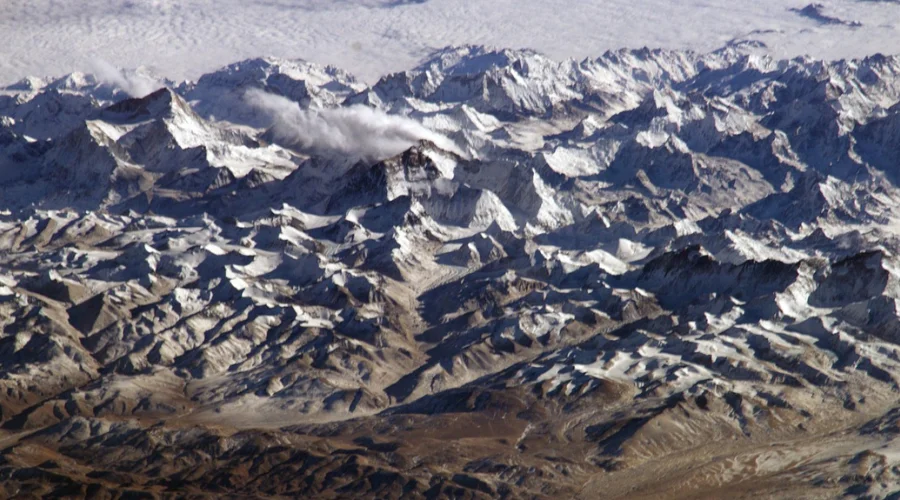Mount Everest is not an ordinary mountain, being the tallest in the world. It is high above the clouds, and throughout centuries it has astonished people by its beauty, mystery, and power.
There are also lots of secrets that can make Everest special. Mount Everest is full of surprises with hidden ice caves and rare plants, as well as ancient fossils and something that makes one feel awe.
This article contains 15 interesting Mount Everest facts that will give you a closer look at why indeed it is one of the most amazing places on Earth.
1. Mount Everest Keeps Growing
People believe that mountains are immovable, indestructible, unchangeable giants but the truth of the matter is that Mount Everest is continuously growing!
This gigantic mountain is built due to the tectonic plate’s movement on Earth. Slowly, the Indian plate is pressing to push the Eurasian plate higher, pushing the Himalayas upwards, including Everest.
Scientists estimate that Everest grows 4 millimeters per year. That may not necessarily sound much, but in the course of decades, it accumulates.
The height of Mount Everest has grown from 8848 meters to 8848.86 meters.
The highest mountain in the world is not only a dead marvel, but a living and moving monument, which shapes. No wonder this mountain that is growing in height literally each year reminds us of the great power of nature.
2. Home of the Highest River in the World
Mount Everest cannot be simply considered a mountain of spectacular heights. It is also the beginning of some of the highest rivers in the world.
The snowfields and glaciers on the Everest supply the Dudh Kosi River, which originates in the high Himalayas and passes through the steep valleys.
The river is crucial to the people of Nepal in that it serves as a source of drinking water, agricultural products, and hydropower in the Everest Base Camp Trek.

The most interesting fact is that this river begins with such a high altitude where the amount of oxygen is scarce, the temperatures are freezing, and the life on the rocky surfaces is hardly attached.
Therefore, Everest is not as simple as a mountain, but it is a life pawn in one of the worst climates on this planet.
3. The “Death Zone” Is Real
It is not only a matter of stamina to climb Everest, but a struggle against the air you inhale. In the Everest region, beyond the elevation of 8,000 meters, mountaineers refer to the death zone.
The oxygen saturation is very low to allow the complete acclimatization of the human body. Each movement is tiring, and the possibility of altitude sickness, frostbite, or even an abrupt death is getting extremely high.
This is the reason why the climbers have supplemental oxygen and spend little time in this zone. The Death Zone is a chilling reminder that Everest is not the mountain. It is the trial of humans to see how strong and endurance it can be put to struggling with nature to the limits of its extreme measures.
4. Everest has Changing Weather
Mount Everest is not only high but also a magnet for storms. The Everest summit experiences one of the worst climatic conditions on earth such as hurricane-strength winds, snowstorms, lightning storms and more.
The temperature at Everest may drop to -60 Degrees Celsius at the peak. These circumstances shift in a few minutes; any sunshine may easily develop into blushing snow, without the least warning.
Sudden storms can frequently halt the progress of the climbers trapping them in the middle of the ascent and forcing them to make it as a survival.
5. A Mountain Full of Trash
Mount Everest is the mountain attracting the highest number of visitors in the world but the glory behind it is not in a form of the praise itself.
Climbers have deposited tones of wasted oxygen bottles, tents, ropes and equipment in the decades. Nor are these garbage, as now dispersed over the mountains, covered with snow, or in some instances frozen for at least many years.
Dream of hiking in the clouds and discovering traces of the previous explorations buried in the snow dead and silent.
In recent years, the biggest clean-up operations have erased the traces of the efforts of the human aspiration, yet Everest contains evidence of human ambitions.
6. Everest Summit is not always snow-covered
The majority of images of Everest have it glittering beneath the heaps of snow. However, it is rather amusing that in the warmer seasons, the low parts of Everest are frequently bear with rough stones.
These bare faces disclose the primeval core of the mountain, which is whitened in the impact of a million years of geological energy.
Starting with jagged cliffs to the sheer falls, these rocky passages impress climbers. The fact that Everest is not merely a picture-book mountain- it is a living and growing thing that time has molded into a shape.

By glimpsing the bare rock underneath the snow, you start to sense that the mountain is exceptionally powerful. It is challenging for adventurers who want to respect it and overcome it.
7. Everest Moves: It is a Rambling Giant
To the majority, mountains can be described as fixed or immovable features, but Mount Everest is steadily moving.
The Indian plate has been constantly moving against the Eurasian plate and is making the mountain move northeastwards at the rate of about 2-3cm annually. And with centuries this amounts to a few meters of motion!
It is possible to think of the same position of the climbers decades ago and the mountain is slightly transformed.
Everest is not merely the highest mountain, but it is an active living entity that ushers us to the realization that even the largest of the landmasses are ever-moving.
8. Mount Everest Has Various Names
Everest is not just a name, but it has vast cultural and spiritual connotations and meaning.
In Nepal, it is referred to as Sagarmatha or Forehead of the Sky, whereas in Tibet as Chomolungma or Mother Goddess of the Universe.
Since time immemorial, it has been worshipped as a deity in the locality with people of the land believing that it holds purity in guarding the people.
Everest climbing is not just a physical feat, but a trip into a land that has been regarded as being filled with spiritual worship across generations.
9. Everest Has Many Fossils
Scientists have found marine remnants of ancient sea animals’ way up at the peak. Suppose that Earth had a peak above which used to be the floor of an ancient deep ocean more than 450 million years ago.
These remains speak silently of the time when the country of Nepal was covered by water, when the Himalaya was not yet even in existence.

Each step brings us to the past of millions of years of the life of our Earth; it is an amazing experience to realize how beautiful nature can change, in a time beyond imagination.
10. The Mountain That Tests Humanity Itself
Mount Everest is not just a rock, snow or ice. It is a challenge to human strength, spirit and perseverance. Thousands have tried it some have been successful, many have failed and unfortunately, some have never come back.
Many climbers faced to biting cold, deposited oxygen, snowstorms and avalanches. Everest is not only a physical challenge, but it is a psychological and emotional challenge.
It is impossible to overcome it or even to stand under its shadow without becoming a different person. The mountain teaches respect and awe and humility.
It is a better way to see that the real summit is not only at 8,848 meters age, but it is in conquering yourself amid the most radical masterpiece nature ever created.
11. The Everest Has Its Unique Ecosystem
Amazingly, Everest can sustain life even in such drastic conditions as very cold and thin air. Lichens, mosses, and hardy plants hang on the rocks close to the bottom and to the mid-slopes, forming green areas through the gray rocks and snow.
This vegetation can endure the most dangerous winds and freezes, and these plants create a very delicate ecosystem that lives silently.
It has even been discovered that even insects such as springtails and little spiders can survive even in high altitudes, and this is how life can be found in the least likely places.
Everest is more than a deserted mountain-top; it is an experimental laboratory where the endurance of nature is put into practice.
12. Sound Behaves Differently on Everest
Sound is strange in the high altitudes. This thin air allows the sound to travel more widely but it becomes less deep and warm. This creates the illusion of quietness and silence even in windy environments among climbers.
Even screaming over a crevasse or hearing the low crack of an icefall is almost strange. It is said that the mountain whispers to many climbers that it is alive, and it is conscious of every footstep that is taken on it.
Everest is not only a towering figure on this land, but it brings forth some sound, like no other place in the world.
13. The Shape of the Everest is Changing with the Seasons
Despite the normal belief of Everest as a fixed mountain, it changes each season. In the monsoon seasons, cloudy snow covers the top, obscuring its rough edges.
The rocks are glittered with ice and frost in winter to form glittering spires. Even the avalanches slightly alter slopes at some level.
To a keen eye, they will never see the same Everest exactly twice. Nature creating a continuous, artistically flowing movement on it. It is a kind of breathing sculpture which varies depending on the light, wind and temperature.
14. The Mountain Holds Mysteries Beneath Its Snow
The Everest has blocks of snow beneath with crevasses, ice pitfalls and ice streams. Other crevasses drop hundreds of meters under the ground that are not even seen until the snow on top collapses.
Ice caves are created by the melting glaciers, and they could be lethally quiet or deafeningly loud with water flowing through them.
Climbers, scientists alike are usually amazed by what is under the surface, a secret world that hardly any human ever beholds.
15. Everest Has More Than 200 Dead Bodies
Mount Everest is a striking beauty, but below the ice-covered surface is a terrible Mount Everest Facts.
The dead bodies of 200 to 300 climbers who never came back are spread all over its slopes. Their high position gives them a cemetery with the mountains being frozen almost perfectly, the extremely cold and low oxygen keeps them in their state of death.
There are those that are covered over with snow and ice, and it is the corpse lying on the ground. Others remain on the trail to catch the eye of the next person and serve as a silent warning of the dead person.
It is almost impossible to retrieve the bodies that were dropped at these elevations, and those who rescue risk losing their lives at the Death Zone, where even standing in one position consumes power.
Send an Enquiry
Error: Contact form not found.
© 2025 - Himalayan Trekking and Tours (P) Ltd. All Rights Reserved.

